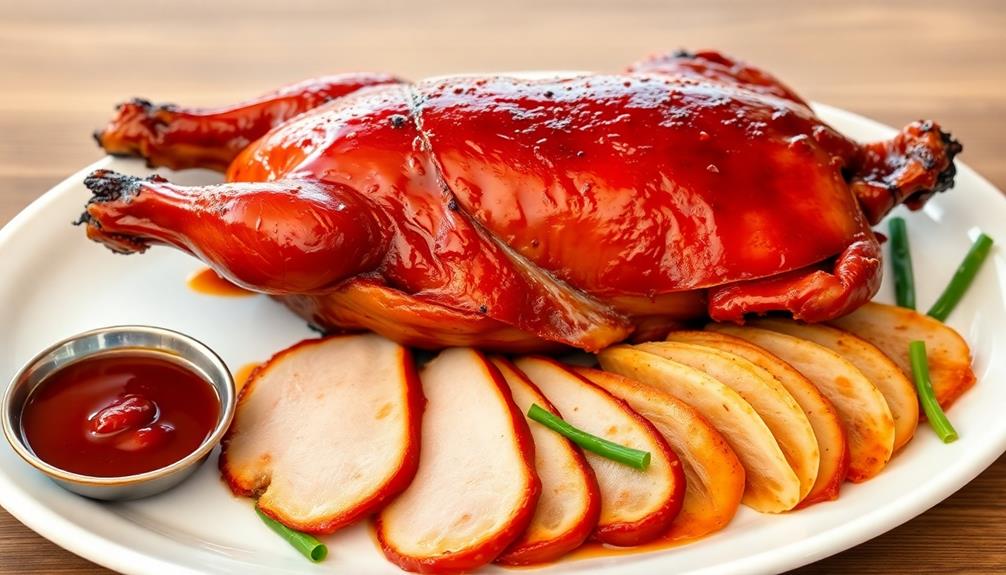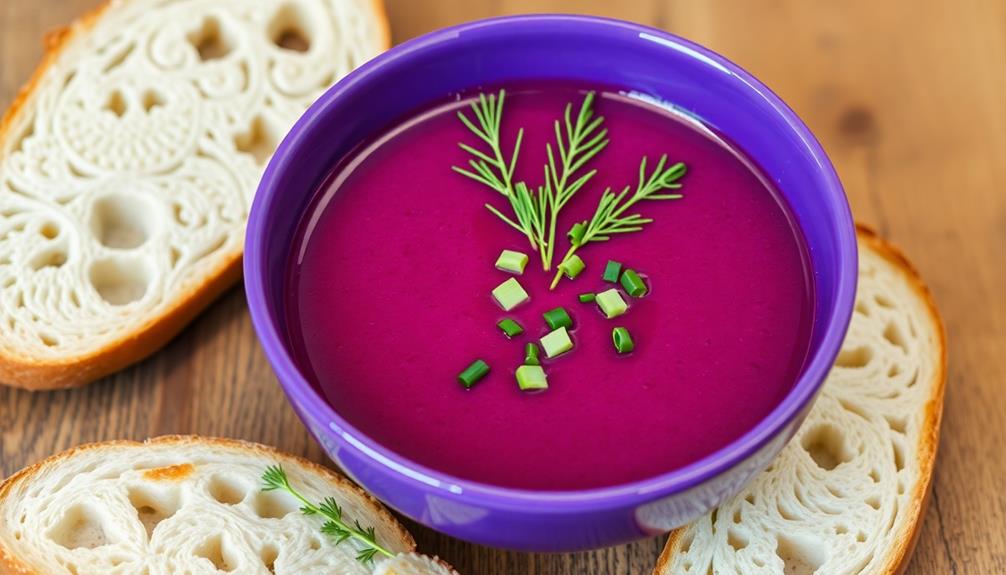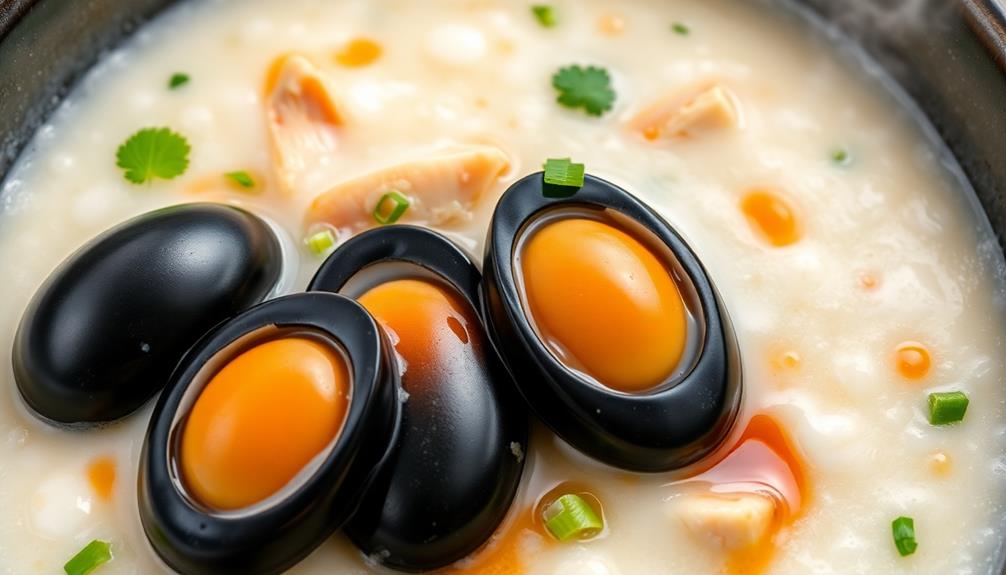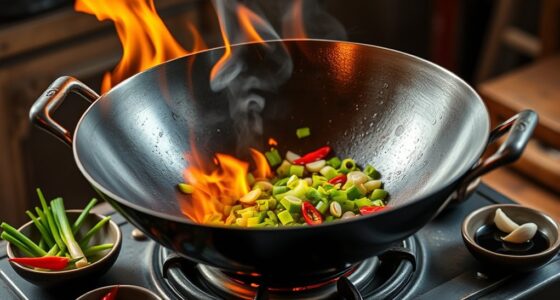Peking duck is a mouthwatering Chinese dish that's been around since the 1300s! Originally, only emperors could enjoy this tasty treat. But today, anyone can try it – and you definitely should! Making Peking duck is a real art form. It starts with carefully drying the duck so the skin gets extra crispy. Then, it's brushed with a sweet glaze and roasted to perfection. Slicing the tender meat and wrapping it in soft pancakes with veggies and sauce makes for a fun, interactive meal. Mastering this dish takes skill, but the delicious results are well worth the effort. Keep reading to uncover the full Peking duck story! Speaking of delicious Chinese dishes, another classic that you should definitely try is the eight treasure rice recipe. This traditional dessert is made with sticky rice, dried fruits, and nuts, creating a sweet and satisfying treat. Its name comes from the fact that it often contains eight different types of “treasures,” such as red beans, dates, and chestnuts. It’s a perfect way to round out a meal after enjoying some mouthwatering Peking duck. To complement your Peking duck feast, consider adding a side of **Sichuanstyle spicy green beans** to bring some heat and balance to the rich flavors of the duck. The beans are stir-fried with garlic, chili, and peppercorns, delivering a bold punch that’s sure to please anyone who loves spicy food. Together, these dishes combine savory, sweet, and spicy elements to give you a true taste of Chinese culinary excellence!
Key Takeaways
- Peking duck is a iconic Chinese dish with a centuries-old history, originating in the Ming dynasty and initially reserved for emperors.
- The dish is renowned for its crispy skin and succulent meat, requiring meticulous preparation techniques like air-drying and roasting.
- Peking duck holds significant cultural significance, representing Chinese culinary excellence and hospitality, and is often served during special occasions.
- The interactive dining experience of Peking duck involves guests assembling the dish with accompaniments like Mandarin pancakes, cucumbers, and hoisin sauce.
- Mastering the preparation of Peking duck enhances one's cooking skills and appreciation for the culinary arts, leading to a sense of accomplishment.
History
The origins of Peking duck can be traced back to the imperial kitchens of the Ming dynasty in the 14th century.
Back then, the chefs would roast these delicious ducks to perfection, carefully basting them to achieve that gorgeous, crispy skin. It was a real treat reserved only for the emperor and his court.
Over the centuries, the recipe and techniques were refined, and Peking duck became a beloved Chinese delicacy.
Today, you can find it in restaurants all around the world. The dish is prepared by hanging the duck to dry, then roasting it in a special oven until the skin is a beautiful shade of mahogany.
The meat is so tender and juicy, and when you pair it with the sweet, fragrant plum sauce, it's simply heavenly.
Whether you're enjoying Peking duck in Beijing or your hometown, it's always a truly special dining experience.
Recipe
Peking duck is a renowned dish that originated in the imperial kitchens of China. Its crispy skin and succulent meat have captivated the palates of food enthusiasts worldwide. Preparing Peking duck requires meticulous attention to detail, but the end result is well worth the effort.
To achieve the signature crispiness of the skin, the duck is meticulously prepared through a process that involves air drying and repeated basting. This process ensures that the skin crisps up to a golden-brown hue, while the meat remains moist and flavorful.
Ingredients:
- 1 (5-6 lb) whole duck
- 1 tablespoon salt
- 1 tablespoon sugar
- 1 teaspoon five-spice powder
- 1 cup boiling water
- 1 cup hoisin sauce
- 1 cucumber, julienned
- 12 Mandarin pancakes
Instructions:
Rub the duck inside and out with the salt, sugar, and five-spice powder. Hang the duck and allow it to air dry for 6-8 hours or overnight in the refrigerator.
Place the duck in a large pot and pour the boiling water over it. Allow the duck to cool completely, then repeat this process two more times.
Roast the duck at 400°F for 45 minutes to 1 hour, basting occasionally, until the skin is crisp and golden brown.
When serving, slice the duck into thin pieces. Accompany with the julienned cucumber, hoisin sauce, and warm Mandarin pancakes. Allow guests to assemble their own Peking duck wraps, creating a truly interactive and delightful dining experience.
Cooking Steps
First, rinse and thoroughly pat the duck dry.
Next, hang the duck for air-drying, which will help the skin get nice and crispy.
Finally, brush the duck with a sweet maltose glaze before roasting it in a preheated oven.
Once it's cooked, carve and serve this delectable Peking duck!
Step 1. Rinse and Pat Duck Dry

After the duck has been marinated, it's time to prepare it for roasting. First, you'll need to rinse the duck under cold running water. This will wash away any excess marinade or impurities on the skin.
Be sure to pat the duck dry with paper towels, making sure to absorb as much moisture as possible. You don't want any water droplets left behind, or the skin won't get as crispy during roasting.
Once the duck is nice and dry, use your hands to gently massage the skin. This will help the fat render out more effectively, resulting in that signature crackly, golden-brown skin.
Make sure to get into all the nooks and crannies, like the wings and legs. With the duck prepped and ready, you can now move on to the next step – trussing the bird. This will help it keep its shape and cook evenly in the oven. After trussing the duck, you can season it with your preferred herbs and spices. Once seasoned, place the duck on a roasting rack in a roasting pan. Some people like to use a traditional dim sum chicken feet recipe to add a unique flavor to the duck. This can be a delicious addition to the dish.
Get ready for some serious Peking duck deliciousness!
Step 2. Hang Duck for Air-Drying
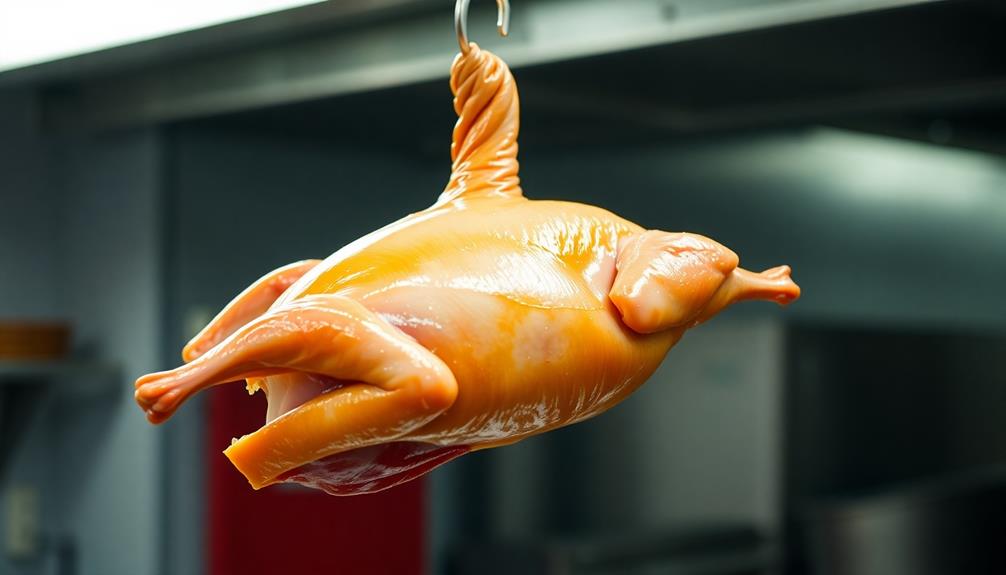
With the duck patted dry, it's time to hang the bird for air-drying. This step is crucial for achieving that signature crispy skin on your Peking duck.
Carefully place the duck, breast-side up, on a rack or hook and hang it in a cool, well-ventilated area. The air circulation will help draw out moisture from the skin, allowing it to become delightfully crisp.
As the duck hangs, don't be tempted to touch or move it. The drying process can take several hours, or even overnight, so be patient. This time allows the skin to tighten and the flavors to concentrate, making your Peking duck an absolute delight.
Keep an eye on the duck, ensuring the temperature remains between 50-70°F. When the skin has transformed into a beautiful, mahogany-colored, and paper-thin layer, your duck is ready for the next step.
With the air-drying complete, you're one step closer to serving up an authentic and mouthwatering Peking duck dish.
Step 3. Brush Duck With Maltose Glaze
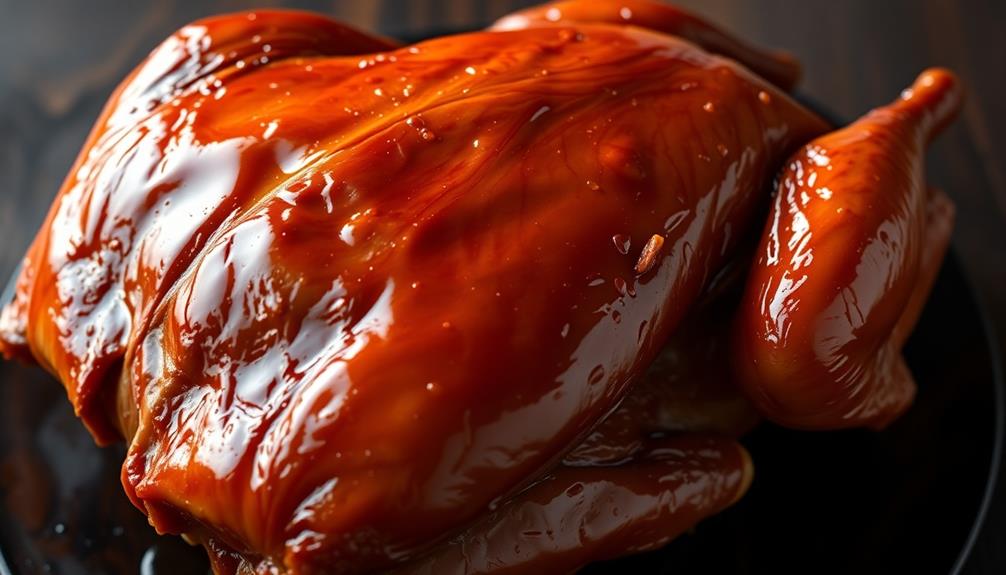
Once the duck has finished air-drying, it's time to prepare the maltose glaze. You'll need to gather a few ingredients: maltose, water, and a pastry brush. Maltose is a sweet, sticky syrup that will give the duck's skin a gorgeous sheen and caramelized flavor.
In a small saucepan, combine the maltose and water, then heat the mixture over medium, stirring constantly until it's smooth and warm. Be careful not to let it boil – you want the glaze to be just hot enough to easily brush onto the duck.
Using your trusty pastry brush, start applying the maltose glaze all over the duck's skin. Be sure to get into every nook and cranny, coating the entire surface evenly.
As the glaze dries, it will create a beautiful, shiny layer that will make your Peking duck look absolutely mouthwatering.
Now, your duck is ready for the final step: roasting to crispy perfection!
Step 4. Roast Duck in Preheated Oven
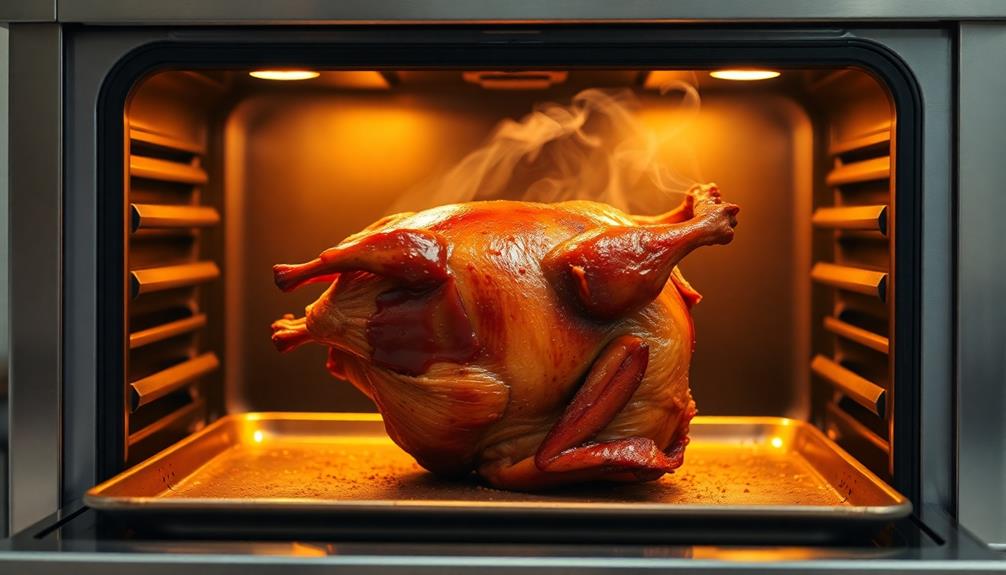
Preheat your oven to a scorching 425°F (220°C). This intense heat is essential for achieving that signature crispy, golden-brown skin on your Peking duck.
Once the oven is ready, carefully place the prepared duck, breast-side up, on a sturdy roasting rack. Make sure the rack is set over a deep baking tray to catch all the delicious juices that'll drip down.
Now, pop the duck in the oven and let it roast for around 50 to 60 minutes. Halfway through, use a ladle to baste the duck with its own juices, ensuring every inch gets evenly cooked.
Keep a close eye to prevent any burning. The duck is done when the skin is crisp and a thermometer inserted into the thickest part of the thigh reads 165°F (75°C).
Remove the duck from the oven and let it rest for about 10 minutes before carving. This final step allows the juices to redistribute, making your Peking duck tender, juicy, and oh-so-flavorful.
Step 5. Carve and Serve the Peking Duck

Carefully transfer the perfectly roasted Peking duck to a cutting board. Using a sharp knife, carve the duck into thin, mouth-watering slices. Be sure to include some of the crispy, golden-brown skin with each piece.
Arrange the sliced duck on a serving platter, making it look as appetizing as possible.
Next, it's time to prepare the traditional accompaniments. Warm up the soft, pillowy Mandarin pancakes and place them in a covered dish to keep them pliable. Slice some fresh, crunchy cucumbers and green onions, arranging them neatly on the platter alongside the duck.
Don't forget the sweet and tangy hoisin sauce – offer it in a small bowl so your guests can generously dip and dollop to their heart's content.
Now that everything is ready, invite your family and friends to dive in! Demonstrate how to assemble the perfect Peking duck wrap, then let them create their own delicious masterpieces.
Encourage everyone to savor each bite, savoring the harmonious flavors and textures. Enjoy!
Final Thoughts
As you savor the final bites of the crisp, succulent Peking duck, you can't help but feel a sense of accomplishment. After all, you've just mastered the art of preparing this delectable dish from start to finish.
From carefully selecting the right duck, to expertly roasting it to perfection, and now, skillfully carving and serving it, you've truly become a Peking duck connoisseur.
As you lick your fingers, savoring the blend of savory, sweet, and smoky flavors, you can't resist a smile of satisfaction. This culinary journey has been a delightful experience, and you're proud of the impressive results.
With each successful attempt, your confidence in the kitchen grows, and you can't wait to share this newfound expertise with family and friends.
Peking duck isn't just a dish – it's a celebration of Chinese culinary tradition. By mastering its preparation, you've not only treated your taste buds but also gained a deeper appreciation for the rich cultural heritage behind this iconic meal.
Frequently Asked Questions
How Long Does Peking Duck Take to Prepare?
Preparing the dish takes time, doesn't it? Typically, it can take several hours to properly cook and assemble a Peking duck, ensuring the skin is crispy and the meat is tender.
What Is the Best Way to Store Leftover Peking Duck?
The best way to store leftover Peking duck is to place it in an airtight container in the refrigerator. This will help preserve the flavor and texture for up to 3-4 days.
Can Peking Duck Be Made Using a Conventional Oven?
You can absolutely make peking duck using a conventional oven. While the traditional method involves a wood-fired oven, the oven in your home can produce a crisp, flavorful peking duck with the right preparation and technique.
Is Peking Duck Suitable for Vegetarians or Vegans?
You can't consider Peking duck suitable for vegetarians or vegans, as it's made from roasted duck. The preparation process involves techniques like air-drying and roasting the duck, which don't align with plant-based diets.
Where Can I Find the Best Peking Duck in China?
You can find the best Peking duck in Beijing, where it originated. The most renowned restaurants include DaDong, Quanjude, and Made in China, all of which offer exceptional Peking duck experiences.
